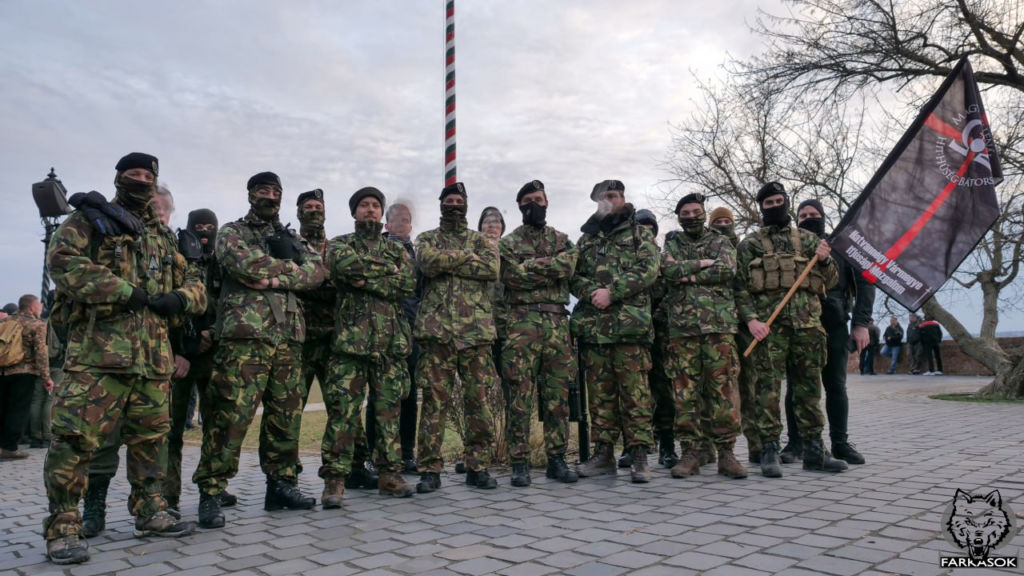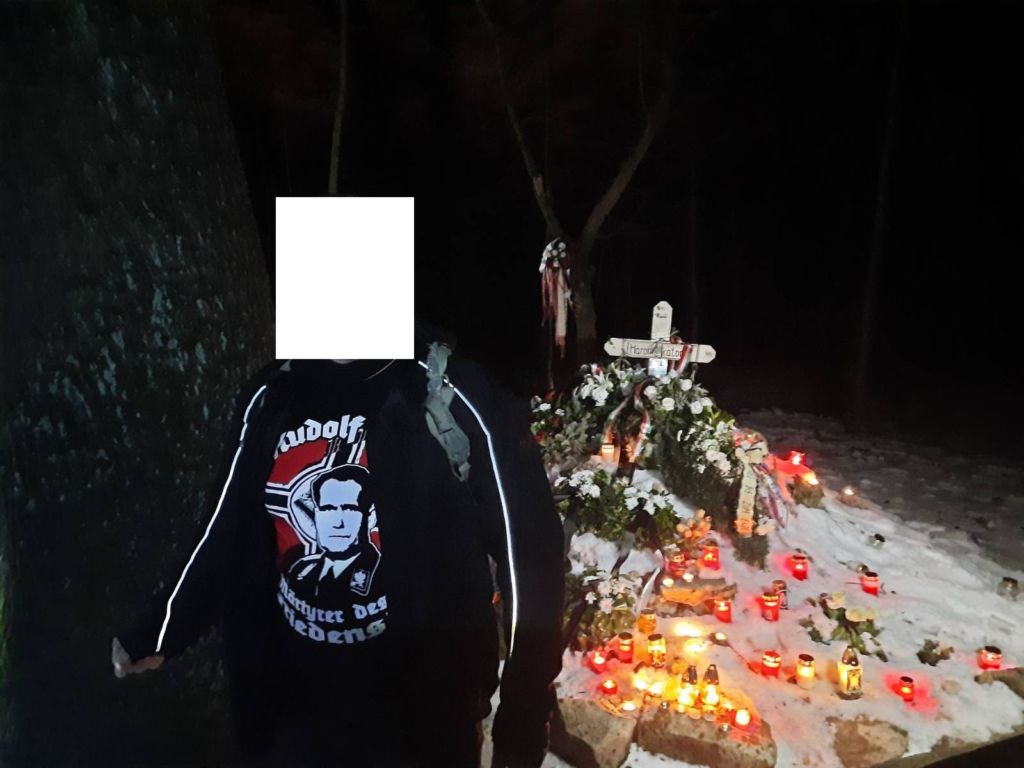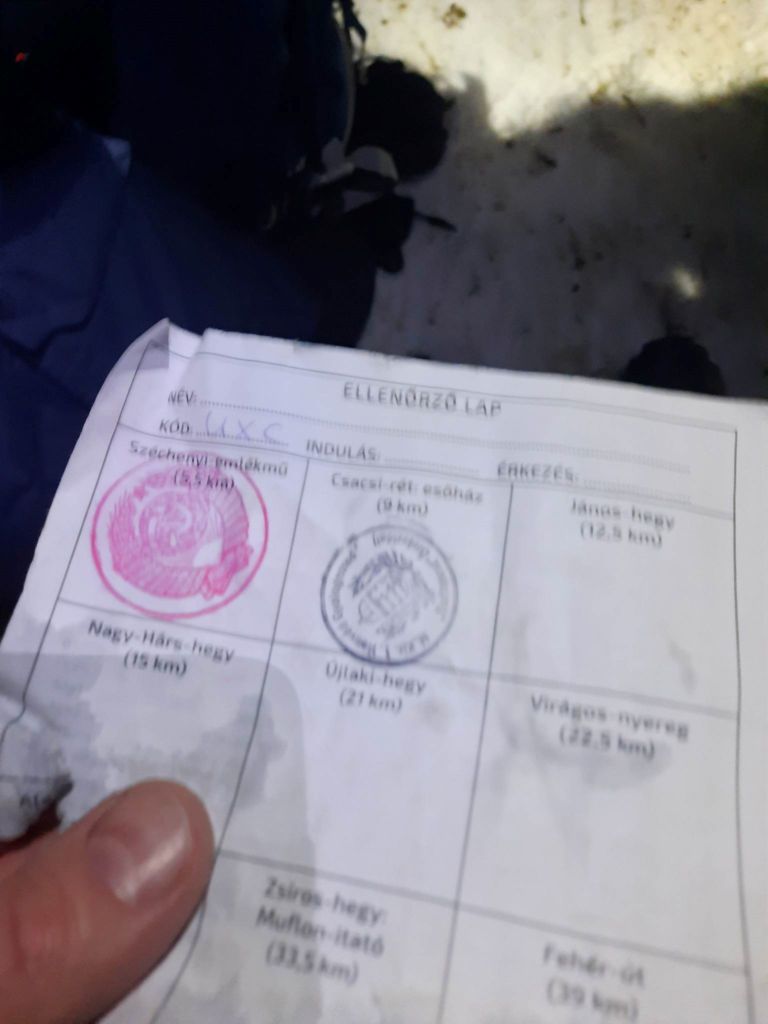My Breakout from the Modern World: The Hungarian Day of Honour Tour 2023, Part 1
Posted By Tizenegy On In North American New Right | Comments DisabledPart 1 of 2 (Part 2 here [2])
Last night I received an envelope containing two commemoration cards from the Hungarian “Hazajáró Egylet” (“Homecoming association”). I plan to keep these cards with me for the rest of my life. They recognize the fact that I successfully completed more than half of a 60-kilometer “breakout tour” that I participated in on Saturday, February 11, 2023.
One of the cards I received was written in German, and the other is in Hungarian. Each one had my name printed on it, with a brief statement acknowledging that I took part in the “breakout” from Budapest. These cards are more than just rewards for participation, because in order to be eligible for one you must complete, at a bare minimum, 25 kilometers of the grueling 60-kilometer hike that starts in the late afternoon, continues all night, and ends Sunday morning.
I did just that earlier this month, and I promised myself along the way that I’d write something to memorialize the incredible experience More importantly, I promised myself I’d write something in honor of those heroes who perished back in February 1945.
If you have not yet already read John Morgan’s excellent summation of what the annual “Day of Honour” memorial hike is all about [3], I suggest you do so before continuing with my personal account of what I experienced on February 11-12, I will quote from John’s summary of the Battle of Budapest, the historical event which the hike commemorates:
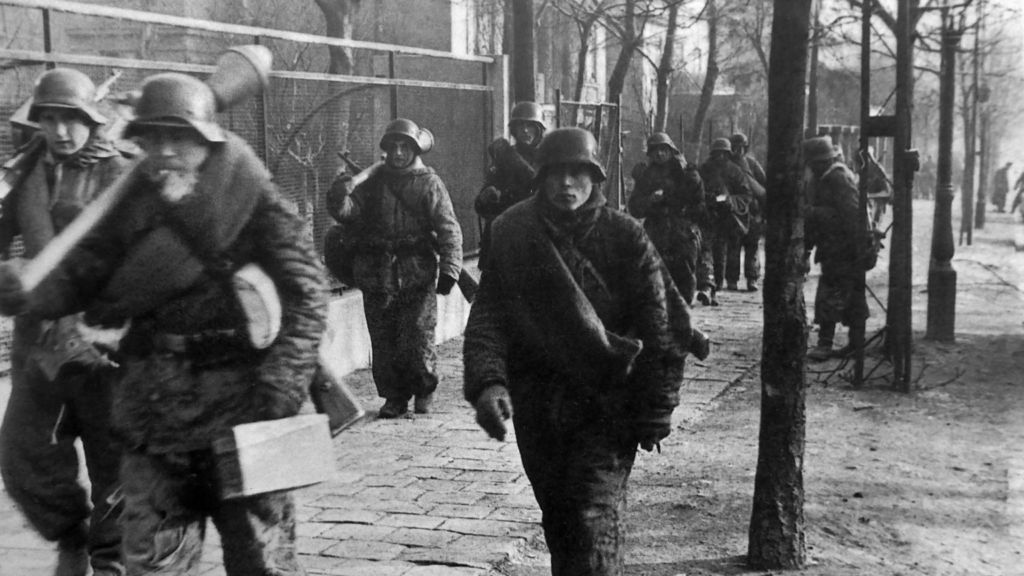 [4]The Battle of Budapest is not as well-known as the other great city battles of the Second World War, such as Stalingrad or Berlin, which is rather tragic since it was no less epic or destructive. But its full significance cannot be understood without knowing how it came about . . .
[4]The Battle of Budapest is not as well-known as the other great city battles of the Second World War, such as Stalingrad or Berlin, which is rather tragic since it was no less epic or destructive. But its full significance cannot be understood without knowing how it came about . . .
In early 1944, realizing that the war was lost, [Admiral Miklós] Horthy began secret negotiations in an attempt to secure a separate peace with the Allies. The Germans soon detected this, and on March 19 they launched Operation Margarethe, occupying key points around the country and effectively rendering Hungary a German vassal state. Nevertheless, Horthy persisted in his efforts, and by October 15, when their forces had already penetrated deep into Hungary, the Soviets accepted an armistice in which Hungary would surrender in exchange for retaining its national autonomy. The Germans had expected this move and immediately took Horthy and his son as prisoners, and informed Horthy that his son would be executed unless he immediately resigned and named Ferenc Szálasi, the leader of the Arrow Cross, as his successor. Horthy reluctantly agreed, although the change in government was largely symbolic, since the Red Army was already well on its way toward Budapest . . .
[T]he battle ended up lasting nearly two months, with intensive fighting street by street and building by building. The Soviet forces and their Romanian allies suffered an estimated 55,000 dead in the fighting; of the Axis forces, 40,000 are believed to have been killed, as well as 38,000 civilians.
As the Germans and their allies were gradually pressed back, they were eventually isolated in Buda Castle (which the Germans had been using as their headquarters) and the surrounding area, and by February 11, their supply lines having been cut, they were nearly out of food and ammunition. Hitler ordered the defenders to fight to the last man, but nevertheless, beginning that night, an estimated 44,000 soldiers began to break out in three groups, in an effort to make it to the new Axis front lines. The effort was largely futile, however — most of the escapees were soon killed or captured, and only 800 actually made it to the front lines.
I only committed myself to the tour a couple of days before it began, when I visited the Facebook event page and gave it a “like.” This was seen by an old friend who asked me if I was actually going this year. I told him that I wanted to go, but that I didn’t want to attempt it on my own. Unfortunately, he couldn’t go himself this year, but he put me in touch with one of his friends who was. He told me I had to register right away before the registration period closed. I wasn’t certain at first, because I didn’t want to commit to something that I wasn’t going to follow through on entirely. I either wanted to do it 100%, or not at all.
The tour is organized such that there are various points at which one can choose to stop prior to the full 60 kilometers. So when my friend asked if I was going to do 25, I said that I would commit to whichever distance his friend was going to do. My friend’s reaction was extremely positive, and I immediately went to the website and registered myself for the 60 kilometer tour.
Little did I know it at the time, but the man who would be accompanying me is a member of the same Hatvannégy Vármegye Ifjúsági Mozgalom (HVIM), or Sixty-Four Counties Youth Movement, that John Morgan wrote about in his article. We chatted on social media about some of the specifics relating to the tour, and I was elated to have had made the commitment to myself and others.
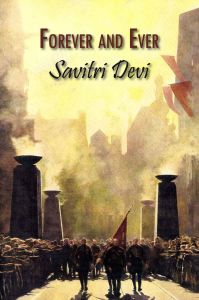 [5]
[5]You can buy Savitri Devi’s Forever and Ever here [6].
When the day soon arrived, I got a proper night’s sleep beforehand, as my friend had advised me to do, and packed my rucksack with all the gear I would need: a warm motorcycle jacket, winter gloves, a balaclava, comfortable black jeans, and adequately worn athletic shoes that wouldn’t too badly irritate a blister I have on the heel of my right foot. This made walking slightly painful, but enough that I couldn’t go the distance — or at least that’s what I thought.
I asked my companion whether we would be within cellphone range throughout the hike, and if mud was going to be a problem; he replied yes to both. He also told me that I needed to be very mindful of my surroundings as I made my way to the tour’s starting point, as foreign antifa had infiltrated the city and were attacking people who they thought were participating in the hike – an unprecedented action that shocked the entire country [7].
I charged my phone, found an old headlamp, and bought water and food for the trip. I departed by bike; I liked having the extra mobility, and I planned to use my bike’s headlamp as a backup light in case my other headlamp failed. I also thought that my bike lock could serve a dual purpose as a defensive tool if I had to use it as a last resort.
My new friend agreed to meet me at a Budapest city square near the hike’s starting point. I arrived early so I could confirm my registration and receive my itinerary. I noticed a very strong police presence everywhere. I knew I stood out — especially if I were to open my jacket, as I had worn my Rudolf Hess t-shirt — but the area seemed like a fairly safe place with the cops around.
When my friend arrived, he assessed that my rucksack was much too heavy, and noticed that I had a bit of a walking issue due to the blister on my heel. But I was determined to give it my all, and he appreciated my enthusiasm. He had to leave, however, to meet another friend who was coming on the tour.
As I walked up to Buda Castle, from where the tour would start, I passed countless other police officers. They all welcomed me, and it was immediately clear they were there for our protection, and not to give us trouble as I’d feared. I reached the starting point at 3:30 PM. There were hundreds gathered, and the area quickly became standing room only.
It was then that I had the first, faint inklings of doubt about whether I had made the right decision. I couldn’t help but notice that the guy next to me was wearing a CamelBak [8]. I asked myself whether I should have prepared better.
It wasn’t until 4:15 that the man I was doing the tour with messaged me and told me he was there. I asked him who and what I should look for. “Around 15-20 guy in dpm military uniform” was his reply. I didn’t quite know what “dpm” meant, so I looked it up on my phone [9]. He also told me they had a flag with them. After some confusion due to the crowd, I finally found the group I was looking for. They literally looked like a paramilitary group, and a couple of them were dressed as Waffen-SS men, wearing the Stahlhelm and SS runes.
“Oh, shit, I’m not sure I’m ready to LARP as a Nazi,” was my immediate thought. But I spotted the man I was supposed to meet, and I introduced myself to him for the first time in person. He directed me to where the registration was. I hurriedly made my way to the registration table, paid the fee, and received my itinerary, and then returned to my guide. He told me a bit more about the antifa attacks and that it was important that we all stay together as a group on the way out of Budapest. “If they really want to fight fascism, why don’t these antifa cowards take their asses to the nearest train station so they can go fight fascism in Ukraine?” I thought to myself.
Before long I was accosted by a photographer who was preparing to take a group photo. He asked me if I’d like to be in it. I said yes, although I quickly donned my balaclava to obscure my face since I had no idea who these guys were. Thankfully, I didn’t look too out of place.
I later realized, when I was sent the above photo by the gentleman with whom I participated, that these men were the HVIM’s farkasok (“wolves”) squad [11], and participation in the annual commemoration march is one of their obligatory commitments. But I didn’t know this at the time.
As we were preparing to leave, I shook hands with several HVIM members who for whatever reason were not joining us for the full tour. I recognized the handshake as the same one, that of the ancient Romans, I had once used when greeting members of the Hungarian chapter of Generation Identity.
My guide told me, “Just follow the flag,” and then joined the column close to the front, near the flag-bearer, as I joined the “wolves” in a two-file column. We began our march out of the castle together, just as the defenders of 1945 had.
I can’t really put into words how I felt at the time. Unbeknownst to me, the HVIM guys recorded a video that captured the moment:
My first “test” as to how well I was doing as an HVIM “wolf” came before we had even left the castle grounds. The team leader came out of the formation, yelling some words in Hungarian I didn’t fully understand, but his intent was obviously to count how many of us there were in order to keep the column together during the hike. Then, starting from the front of the column, man by man, each of us shouted out a number in Hungarian, sequentially progressing from one to however many of us there were:
“Egy!” — “Kettő!” — “Három!” — “Négy!” — “Öt!” — “Hat!” — “Hét!” — “Nyolc!” — “Kilenc!” – “Tíz!”
“Oh, shit,” I thought to myself. “What’s the word for eleven in Hungarian?”
Before I could venture a guess, the team leader jumped in by touching my shoulder as he yelled, “Tizenegy!” Then:
“Tizenkét!” — “Tizenhárom!” — “Tizennégy!” — “Tizenöt!” –“Tizenhat!” . . .
Then the march continued. Along the way, I was tapped on the shoulder by a Hungarian who asked me a question I couldn’t understand. The guy standing to my left answered for me. It turned out he had not known — just as I had not known — that I would be joining the “wolves” for the tour. But the man next to me told him it was all right.
“I hope it will be all right,” I said to myself as we hiked two abreast out of the castle complex and onto the streets of Budapest.
 [13]
[13]You can buy Jonathan Bowden’s Pulp Fascism here [14].
I soon discovered two unpleasant facts I had been blissfully unaware of prior to the hike. First, the terrain as one leaves the city of Buda and enters the Buda hills is massively uphill. And seond, my rucksack weighed far too much to comfortably hike uphill for extended periods of time, even if I had been in the best shape of my life — which I wasn’t. My friend was completely right when he had warned me about this.
I was, however, extremely thankful to be in the company of the young men of the farkasok. Aside from their protection — the antifa terrorists [15] happened to be targeting anyone who even looked like they were participating in the hike.
I started conversing with my travelling companions. When I told one of them that it was my very first time going on the tour, he asked me how far I was going. I told him that I wanted to do the entire 60 kilometers, but that I would reassess after 25. He told me the first 25 are the most difficult, because they involve a lot of uphill and downhill hiking, but the 35 after that are a lot more level. I smiled, and he offered me some chocolate that he had brought with him. Another lad shared a small piece of sausage that he had brought with him.
As it turned out, the leader of the farkasok was taking us on a shorter route out of the city as the bird flies, yet steeper than the one that most of the hikers were taking. We thus made obvious targets for any antifa untermenschen who might have been lurking in the shadows, especially now that the Sun had set. I did everything in my power to keep pace with the others in the formation, but despite my best efforts, I started to lag behind. As we ascended a street that climbed up a steep hill, one of the farkasok slowed down to walk with me and chat.
As it turned out, this lad knows John Morgan. He and I had a genuinely nice conversation about topics and authors of mutual interest — Traditionalism, Julius Evola, Ernst Jünger, Alexander Dugin — to name a few. I also told him that I was worried about my physical capacity to complete the tour, and he told me that the most important thing is not to stop and just keep moving.
And so I kept moving.
He and I caught up with the others at the next intersection. I saw they were waiting for us, so as we caught up to them I yelled out, “Köszönjük!” (Thank you!) They smiled, and I got to enjoy a brief respite during which I had a conversation with the man who was my “guide.” He asked how I was doing; I lied and told him I was “doing all right.” Hungarians never tell polite lies to one another when asked how they are doing; they will tell you in detail exactly how they are doing, regardless of whether it is good or bad. But since there wasn’t anything anyone there could do to help me, I kept my feelings to myself.
It was quite obvious that I was showing signs of physical exertion due to my heavy breathing and uneven gait as a result of the blister. My guide told me that there are frequent checkpoints, and that everyone has a chance to rest for a while, because at these checkpoints many participants have to stand in line to have their itineraries stamped to show how far they got on the hike. (None of the awards one can receive for participating in the hike are granted unless one can show proof that he did the full hike, and the itinerary stamps are the only way to prove it.)
I asked my guide how much further it was to the first checkpoint, which is 5.5 kilometers into the hike. He told me it was about another two kilometers. Shortly thereafter we began another steep ascent, after which we came to a street that was fairly straight but also very steep. The entire hike up to the first checkpoint was nothing but one major uphill climb.
It was here that I fell behind and, to my chagrin, left the farkasok’s company, although for the remainder of my hike through the wilderness — which lasted until about 5 AM on Sunday — I held on to the dream that I would reencounter them at the end of the tour. What a glorious moment that would’ve been!
Once I made my way to the top of the street, I joined up with a large group of other hikers, as I was back on the established route. I finally arrived at the first checkpoint and adjusted my bag as I retrieved my papers to show to the soldiers who were manning the first checkpoint. All of them were wearing uniforms that wouldn’t have looked out of place in 1945.
I then continued the uphill journey, thankful that the ascent was — temporarily — a lot less steep. The police had blocked off the intersections, and I was thankful they took the protection of the tour participants seriously. We soon left the paved roads behind and entered the forested wilderness of the Buda hills.
I came upon the first memorial to fallen Hungarian soldiers shortly before reaching the second checkpoint, and asked another hiker to take a photo of me in front of it.
I finally arrived at the second — 9 kilometer — checkpoint. This one had more soldiers than the first, and they were seated at a table. I received my stamp and checked my phone. The friend who had convinced me to sign up for the tour had written to ask me where I was. I sent him a photo of myself holding my itinerary with the two stamps in it. “Hajrá!!!” (Go!) he replied. I also sent the photo to the man who had been my guide at the beginning of the tour.
The next leg of the journey was a slow uphill trudge, but thankfully there were plenty of other hikers to keep me company. I was proceeding at the same pace as most of them, but occasionally other hikers would pass me by. Everyone I encountered was kind.
“March on, march on,” I kept telling myself. A track from an old Der Blutharsh album kept repeating in my head; its lyrics keep repeating, “Kampf, sieg, oder Tod!” (“Battle, Victory, or Death!”) to the sound of drumbeats . . . I was thankful that we no longer had to worry about Soviet snipers hiding in the trees, like the soldiers of 1945.
The uphill trudge finally ended at another checkpoint that was manned by friendly German soldiers (who were of course Hungarian reenactors). One took my itinerary — which I was beginning to think of as a passport — and gave me my third stamp, while another handed me a small candy bar. “Danke sehr!” I told him.
There was a canteen and some picnic tables at this checkpoint, so I sat down to take a brief rest. I was officially at 12.5 kilometers at this point — halfway through the 25-kilometer tour. I felt relieved and almost celebratory. The temperature was at the freezing point, so my extremities were cold and my hands were starting to get frostbitten. I opened my backpack and noticed I still had plenty of water, so there was no need to replenish it just then. I looked in vain for the guys with whom I had started my journey. I wasn’t hungry, just cold, exhilarated, and happy I’d made it as far as I had.
I checked my phone and saw that I had received a reply from my guide. He had given me a thumbs-up react to the photo I sent him of my itinerary, and said that he and the other guys were at the third checkpoint.
I then started my trek to the 15 kilometer checkpoint. Along the way I found myself trekking next to an older man who could tell I was struggling a bit. He asked if I needed help. He only spoke Hungarian, so we only had very basic communication. But he did offer me a small LED flashlight which I accepted, and when we parted ways he didn’t ask for it back. I have it with me now, and will keep it as a souvenir. I will always be thankful to him.
 [18]
[18]You can buy The World in Flames: The Shorter Writings of Francis Parker Yockey here. [19]
On this stretch I had the humbling experience of being passed by women and children who were hiking at a faster pace than I was. I saw it as part of humbling my ego out of reverence for something greater: reverence of the heroes who had died defending Budapest in 1944-45.
I finally arrived at the fourth checkpoint. We were at the top of a hill, and it was quite a sight to behold to look back at the literally hundreds of people who were doing the tour with me, each illuminated by a headlamp or flashlight.
There was a friendly German soldier at this checkpoint with a full Hindenburg mustache. He kindly directed everyone to the table for the stamps. The next checkpoint was six kilometers further on. I had hoped the terrain would level off somewhat, but things only became more treacherous, as there were steep ascents and descents, and the trail was covered with light snow that had frozen and turned to ice in some places. I wasn’t wearing hiking boots with any kind of tread, nor did I bring hiking poles I could have used to steady my balance, so I soon began to slip and slide as I made my way forward.
It was during this stretch that I met another older man. He thought I was German upon seeing my Rudolf Hess shirt, and he spoke some German and English in addition to Hungarian. I told him that this was my first tour and that I was attempting the 60-kilometer hike. He welcomed me, then told me that it was his sixth 60-kilometer tour since 2006. He also told me that he had first done the tour in 1988, when Hungary was still a Communist country and the Red Army was still occupying the country. The hike had been unofficial and illegal back then, of course.
This man helped me remain steady as I kept moving forward. We sang a few “forbidden songs,” even though he found my slipping and sliding on the ice quite amusing. But he kept telling me not to have any fear and to just keep moving forward. I fell on my ass several times; sometimes the safest thing to do was to sit down and slide down the ice on a hill rather than attempt to walk down it. Thankfully, every time I fell I was able to get back up quickly.
My brief companion and I parted ways before reaching the next checkpoint, and I never heard his name, but I couldn’t write about my experience without acknowledging him. He carried my bag for a good portion of the time we were together as well. This was in spite of the fact that he was in his mid-60s, by my estimation.
The hill we had to cross before the fifth checkpoint was very steep, and I took a breather along the side of the path for a while. The trail was steep enough that I could rest on my back and was still vertical enough to be able to see all the hikers on the trail. The parade seemed to never end, and even with all the people there was a peaceful quiet in the air.
That would soon end.
At the fifth checkpoint there was a fire in a steel barrel that I used to warm my hands. There were also a lot of (unfriendly) Red Army soldiers — Hungarian reenactors, of course — brandishing weapons. I turned my phone on briefly to try and take a photo, but unfortunately it had only enough juice to show me that it was 11:57 PM. Then the battery died. I did, however, manage to find a photo that was posted by another hiker afterwards:
From this photo you might get the impression that the woman in the Red Army uniform is a kind and sweet lady. Maybe she is; I don’t know. But when I got there, there was a crowd of hikers waiting to get their stamps. She kept incessantly gesturing with her hands and yelling, “DAVAI!” “DAVAI!” (Give it!)
I was happy enough to have reached the checkpoint that when I presented my papers to be stamped, I tried to make eye contact with her and yelled back the one word I know in Russian that isn’t “da” or “nyet.”: “Spasibo!” But instead of responding in kind, she just kept shouting without making any eye contact or acknowledging my existence. “How rude!” I thought. At least I had another fresh stamp in my itinerary before I left. This one was of a massive T-34 tank.
A few minutes later, one of the Soviet barbarians in the photo above lifted his PPSH-41 submachine gun and started firing into the air! How reckless and insane those damn Russians are! “No more vodka for them,” I thought.
After a brief respite, I continued on. I took a wrong turn, but thankfully I did so with a group of other hikers who quickly realized their error. We backtracked together and resumed the adventure. The next checkpoint, at 22.5 kilometers, was only a kilometer and a half further on — but again, through mountainous and treacherous terrain.
I was relieved and exuberant when I arrived. As it turned out, there were two checkpoints: a 22.5-kilometer checkpoint for the 60-kilometer tour, and a separate, 25-kilomter one that serves as the final goal of the shorter hike, which was inside a tent. The mood in the air was quite festive, as the ones doing the shorter hike were thrilled to have completed it. I, on the other hand, had decided at the outset that I was either going to do the hike all the way, or not at all. So I walked up to the checkpoint for the 60-kilometer tour. There were four German officers standing there, with a Third Reich flag brazenly displayed in front of the table behind which they were standing.
I handed them my travel document, wishing them “Guten Abend!” The men saw my Rudolf Hess shirt and gave me nods and approving smiles as they gave me my sixth stamp of the evening. I did my best to explain to them in German that my reason for wearing the shirt was that Rudolf Hess sought peace rather than war, but I couldn’t tell if they understood me or not.
I then entered the canteen and enjoyed some hot tea and soup. I then felt energized enough that I decided to follow through with the full tour. But the rest of my journey took on a very different character, because up to that point I had been hiking with many other participants. During the final 35 kilometers — as I saw it at the time — I would be alone for large stretches, because many hikers had stopped at the 25-kilometer checkpoint. But I’m glad I went on, because it was during this latter part of the tour that I had my most profound philosophical and spiritual insights.
To be continued . . .
* * *
Counter-Currents has extended special privileges to those who donate $120 or more per year.
- First, donor comments will appear immediately instead of waiting in a moderation queue. (People who abuse this privilege will lose it.)
- Second, donors will have immediate access to all Counter-Currents posts. Non-donors will find that one post a day, five posts a week will be behind a “Paywall” and will be available to the general public after 30 days.
- Third, Paywall members have the ability to edit their comments.
- Fourth, Paywall members can “commission” a yearly article from Counter-Currents. Just send a question that you’d like to have discussed to [email protected] [22]. (Obviously, the topics must be suitable to Counter-Currents and its broader project, as well as the interests and expertise of our writers.)
To get full access to all content behind the paywall, sign up here:
Paywall Gift Subscriptions
 [23]If you are already behind the paywall and want to share the benefits, Counter-Currents also offers paywall gift subscriptions. We need just five things from you:
[23]If you are already behind the paywall and want to share the benefits, Counter-Currents also offers paywall gift subscriptions. We need just five things from you:
- your payment
- the recipient’s name
- the recipient’s email address
- your name
- your email address
To register, just fill out this form and we will walk you through the payment and registration process. There are a number of different payment options.

